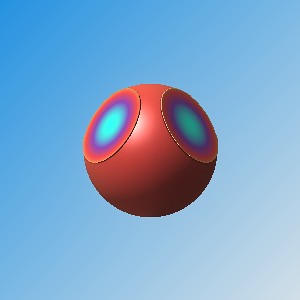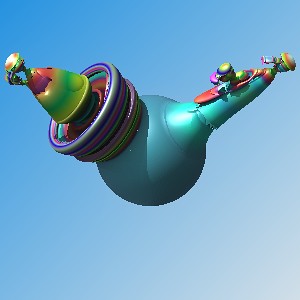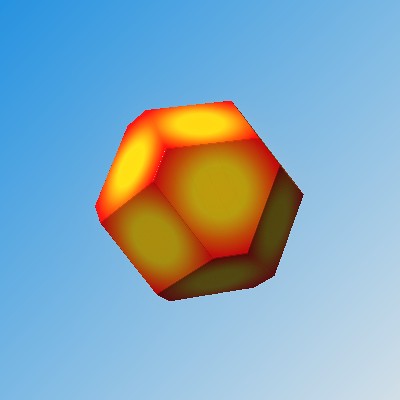This is an attempt to produce a 3D fractal algorithm that had a more intuitive connection between the algorithm and knobs and the resulting image.
The basic idea is much like the complex methods which perform an angular remapping of the unit sphere with a radial power.
 * |Z|^p + C.)

.
The spherical remapping however is specified geometrically. It starts with a identity mapped unit sphere. Then circular patches are added to the sphere. Each patch remaps the sphere and may or may not map its self. The center of the patch maps to the opposite side of the sphere. In the image below the circular patches are represented as planer cuts.

The inverse mapping points (center of the circles) are analogous to the negative real axis in the power 2 Mandelbrot. The inversion has the property of pulling higher values of

into the convergent set. Inverse mapping points also promote the proliferation of orbits. The analogy is if you travel to the other side of the world, you will see a lot of sights along the way.
The identity mapped regions tend to suppress convergence and is analogous to the positive real axis of the power 2 Mandelbrot. In the tinker tower construction these regions are 1D or 2D which differs from complex bulbs which are only identity mapped at discrete points.
The identity mapped and near identity mapped regions end up suppressing fractals over much of the surface. Fractals are found only where orbits form by jumping from tower to tower. This ends up recursively copying and distorting images of the towers. Magnifications of these regions show the same pattern of smooth areas with an occasional tower recursion. The following image is Tinker Towers formed from the remapping of regions from the previous image.

The tower on the left is made using a self mapped patch. The wall is formed by orbits whose first iteration maps near the center of the patch, and whose second iteration maps to the opposite side of the sphere. Orbits which include a mapping to

tend to pull higher values of

into the convergent set. The tower on the right is derived from a non-self mapped patch. A zoom of this tower shows the first reflection of the left tower where the first iteration maps to that tower.

The number of mapping circles is only limited by computing time and taste. There are simple logN algorithms so the computing time can be mitigated.
One may also ask what happens when the circles over lap. If one uses the cut sphere analogy one finds that a soap bubble tessellation results. The soap bubble tessellation algorithm separators overlapping circles with a straight line between the intersecting points. This reproduces the Voronoi tessellation if all circles have the same diameter and cover the entire sphere. The following image is a truncated octahedron made by 14 overlapping slices.

The resulting tinker towers is a bit on the busy side but zooms of the towers often produces interesting results.

All images were produced using the Mandelbulber renderer.


















